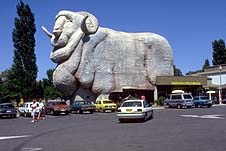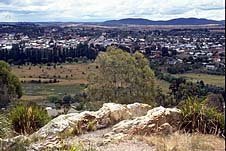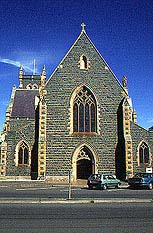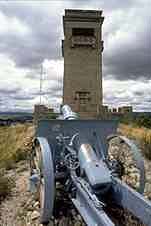
|
| The Big Merino
|
Goulburn (including Towrang, Bungonia and Oallen Ford)
Principal rural settlement of the Southern Tablelands
Goulburn, one of the nation's earliest inland settlements,
is located on the Southern Tablelands at the confluence of
the Mulwaree and Wollondilly Rivers. It is 194 km south-west
of Sydney via the Hume Freeway and 640 m above sea-level
with a current population of 17 000 people.
Goulburn is the commercial locus of an important
agricultural and pastoral region. The 'Big Merino', on one
of the main arteries, attests to the long-standing
importance of wool-growing in the area. Goulburn is also a
major manufacturing base and an important rail centre. Other
income is derived from engineering, warehousing and
distribution, government agencies, retailing, meat
processing and tourism. Goulburn is also home to the NSW
Police Academy which occupies 48 hectares within the city.
Prior to European settlement the area was inhabited by
the Gundungura Aborigines. In 1798 John Wilson and his party
became the first Europeans to see the Goulburn Plains. In
1818 the exploratory party of Hamilton Hume and James Meehan
traversed the Plains and named them after Henry Goulburn,
the British Secretary of State for the Colonies.
The following year Governor Macquarie ordered the
construction of the Great South Road (the basis of the Hume
Highway) from
Picton to the Goulburn Plains. He travelled to the
Plains in 1820 and found 'a noble, extensive, rich meadow
near a fine large pond of fresh water, the cattle being up
to their bellies in as fine, long sweet grass as I have seen
anywhere'. He also noted the good water supply, timbered
hills and general suitability of the area for grazing and
crops. Two days later John Oxley became the first European
to walk upon the future townsite.
Settlers soon followed in Macquarie's wake. The first on
the townsite was Andrew Allan who arrived in 1825. The
Plains were used for stock-raising and wheat-growing
although wheat production slowly faded out from the 1860s.
Goulburn's reputation as a producer and exporter of fine
merino wool was established in the early 1830s although
transportation to Sydney was agonisingly slow until the
1850s. The fruits of the pastoralists' success are evident
in the distinguished colonial mansions which dot the local
landscape.
A town plan was drawn up in 1828 with a view to settling
discharged soldiers. A few allotments were taken up but
Governor Bourke thought it too flood-prone and, in 1832,
ordered a re-survey on higher ground. The new site was
gazetted in 1833 while the original site is now part of
Goulburn North. An inn and store were operational by 1832.
The Great South Rd was re-routed by Thomas Mitchell in
the 1830s and Goulburn was placed in its trajectory for the
first time, rendering the new town a major stopover and
regional centre.
The establishment of a lock-up in 1830 and a
gallows/flogging post in 1832 reflects the fact that
Goulburn was also a garrison town in the early days. This is
related, firstly, to the fact that Goulburn was a centre for
police parties hunting highwaymen who frequented the area
until the arrival of the railway. Bushranger John Williams,
alias 'Duce', a member of 'Blue Cap's' gang, was born at
Goulburn in 1846 and it was in Goulburn court that Frank
Gardiner was convicted of horse stealing and sentenced to
seven years gaol at Cockatoo Island. Ben Hall's bushranging
gang, including John Gilbert and John Dunn, harried the area
in the mid-1860s. They raided homesteads and vehicles on the
Great South Rd, including the Sydney Mail Coach. A sign
adjacent the Goulburn-Braidwood Rd, 17 km south of town,
details a confrontation between the gang and the four
Faithfull brothers (all in their teens) who successfully
repelled the attack from their wagon during a running gun
battle.

|
| View of Goulburn from War
Memorial Lookout |
Secondly, a major stockade for chain-bound convicts and
others involved in the construction of the Great South Road
was located at Towrang, 15 km north-east, from around 1836
to 1842. The stockade became the principal penal
establishment in the southern district and was noted for its
harsh discipline. There were usually at least 250 convicts
hutted there. They slept on bare boards with a blanket
apiece, 10 men to a box or cell. One of the two official
floggers was later found murdered.
The first school and church opened in 1839 and the
Goulburn Herald, one of Australia's first country
newspapers, was established in 1848. It was later
incorporated into the Goulburn Post which is still
published.
The settlement began to expand after 1850 due to a number
of causes: the pastoral industry had expanded, gold was
discovered at
Braidwood in the early 1850s (although a local labour
shortage was the immediate result), selectors began to
arrive from the 1860s and the railway was opened in 1869,
facilitating access to the Sydney markets. The town remained
the southern railhead until 1875.
As a result of these developments, Goulburn was gazetted
as a municipality in 1859 and it became the first inland
Australian city in 1863. The railway was especially crucial
as a catalyst for the town's boom period in the 1870s and
1880s when industries such as coach-building, iron foundries
and saddlery-making began to develop. In 1884 a new gaol at
North Goulburn was completed. It is still functioning as a
rather notorious maximum-security prison. A dairy factory
was set up in 1901 and woollen mills in 1922. Goulburn has
also been a major wool sales centre since 1930.
The grave of energetic exploratory pastoralist Patsy
Durack is in the pioneer cemetery. He died in Fremantle on
20 January 1898 and was buried there. Later he was
reinterred in Goulburn. Famous explorer William Hovell is
buried in St Saviour's Cemetery in Cemetery St.
In the literary sphere, distinguished poet Christopher
Brennan taught at St Patrick's College at Goulburn in 1891
and noted Australian author Miles Franklin (born 1880) lived
on a property at nearby Thornford from 1889 to 1903. She
began writing in 1895 and published her first prose piece in
the Goulburn Evening Penny Post in 1896. Her best known
work, My Brilliant Career, was written in 1898-99 at
Thornford, which features in that work, in Pioneers on
Parade (1939) and My Career Goes Bung (1946).
The Lilac City Festival is held annually on the October
long weekend. It includes the Lilac City Country Music
Jamboree. The Australian Blues Music Festival is held in
February, as is the Goulburn Rodeo. March witnesses the
Goulburn Show and the Goulburn City Rose Festival.
Things to see:
Tourist Information
The Goulburn Visitors Information Centre is located at 201
Sloane St, tel: (02) 4823 4492. Brochures are available
outlining the Heritage Walking Tour (guided tours are
available for groups). There is also material relating to
the Wollondilly Walking Trail (which follows the river for
20 km), the Grafton Street Walk, the Governor Macquarie
Walking Trails (focusing on Mulwaree Ponds) and the Goulburn
District Driving Tours. The latter outlines drives around
town, to Wombeyan Caves and to Canberra. Enquiries can also
be made here about the Open Garden Scheme.
The Visitors' Centre is located in the old technical
school building (1886-87) which is behind the former
mechanics' institute (1881).
Post Office and Town Hall
Around the corner in Auburn St is the imposing Italianate
post office with its large clock tower and colonnades. It
was designed by James Barnet and built of stuccoed-brick in
1880-81. The adjacent town hall building (now the McDermott
Centre) is a Classical Revival red-brick structure with a
small curved iron-lace balcony and Dutch gable, built in
1887-88 and used by the council until 1990.

|
| St Peter and St Paul's
Roman Catholic Cathedral |
St Peter and St Paul's Catholic Cathedral
Turn right into Verner St. At the top of the hill is St
Peter and St Paul's Roman Catholic Cathedral (1871-89), a
Gothic Revival structure built of bluestone with sandstone
tracery, slender moulded columns, a marble sanctuary and an
1890 organ. It was erected around the original church (1843)
which was then demolished and taken out through the doors.
Tech College and Baptist Church
Diagonally opposite is the former Technical College (1901),
once the high school and now the TAFE School of Music.
Slightly further along, at Bourke and Church, is the Baptist
Church, built as a Presbyterian Church in 1887.
St Saviour's Anglican Cathedral
The Baptist Church suffers just a tad from standing opposite
St Saviour's Anglican Cathedral (1874-84), an outstanding
and elegant Gothic construction in white sandstone. It was
designed by noted colonial architect Edmund Blacket who
considered it one of his best works.
Highlights include the rich interior with its
stained-glass windows, chapels, wood and stone carvings,
intricate window traceries, font, hammer-beam roof,
luxurious and ornate sanctuary, the remarkable bishop's
throne, the pulpit with its alabaster columns, the
bas-relief copy of Leonardo's Last Supper above the altar,
and the magnificent organ which features 2252 pipes. The
life of Jesus is told in stone and glass around the
cathedral. The tower and bells were added in 1988. The hall,
also designed by Blacket, served as a temporary church in
1874. Guided tours are available from 1.00 p.m. to 4.00 p.m.
on Sundays and from 10.00 a.m. to 4.00 p.m. every other day.
It is located in Bourke St, tel: (02) 4821 2206.
Goulburn Regional Art Gallery
Adjacent the cathedral is the Goulburn Regional Art Gallery
which is open from 10.00 a.m. to 4.30 p.m. from Tuesday to
Friday and on Saturdays and public holidays from 1.00 p.m.
to 4.00 p.m., or by appointment, tel: (02) 4823 0443.
Montague St and Fibre Design
Cross the road and walk along Montague St which features
some lovely homes and gardens and a variety of architectural
styles. To the left are the Art-Deco Elmslea Chambers and,
at no.11, the old fire station (1890) with its fine rendered
facade and bell tower on cast-iron columns.
At 9 Montague St is Fibre Design, located in a 1902
structure. There is a gallery of textile works along with a
range of handmade products (hand painted silk, ceramics,
glass, jewellery, woven clothing, felted hats and jackets)
along with supplies for fibre work and handspun wool. It is
open daily, tel: (02) 4822 1333.
5-7 Montague St is of interest and over the road is an
elaborate Italianate building erected in 1887 as a
country-town emporium.
Churches and School
Turn left into Auburn St then left into Clifford St, passing
St Andrew's Presbyterian Church (1924-25). Turn right into
Bourke St and on your left is the primary school. It was
established in 1858 as a private enterprise and became the
town's first public school in 1868.
Turn right into Goldsmith St and to the left is the
Gothic-style Uniting Church (1870-71).
Grafton St
Turn left into Auburn St, right into Bradley and left into
Grafton St. A short distance along, to the right, is the
Coach & Horses Inn, built in 1840. Grafton St was originally
the main highway from Sydney and hence had 11 hotels at its
peak. Its width was to permit bullock drays and horse carts
to turn around. Almost all of the buildings in Grafton St
date from the Georgian and Victorian eras. They are outlined
in the Grafton Street Walk brochure.
Reynolds St
Reynolds St veers off to the left. Note the Sisters of St
Joseph Convent (1883) and the Southern Star Inn (1860).
St Clair
Return along Grafton St, cross Bradley St and proceed along
Sloane St. To the right, at no.318, is an early 18-room
colonial townhouse known as 'St Clair' (1845). It features
the original cedar panelling and stringybark floors and a
verandah with fluted sandstone columns capped by a Classical
stone entablature. The building is now home to the local
historical society which displays museum items and conducts
family research on weekends from 1.00 p.m. to 4.00 pm., tel:
(02) 4821 1156.
Sloane St
On the same side of the road, by the Goldsmith St corner, is
a former hotel, built in 1858 and now home to R.J. Sidney
Craig undertakers who set up shop in Goulburn in 1837,
making them the longest-established undertakers in NSW.
At Sloane and Clifford is the police station. The
building to the right of the main entry path was built as a
hospital and remained so until 1889.
Continue along Sloane St. Just past Verner St a short
side road leads down to the Classical Revival railway
station (1869). The stationmaster's residence (1869) has
steep gables and a charming fretwork porch.
Return to Sloane St. On the far side of the road is the
Coolavin Hotel which started out as a bank in the late
1850s. It retains its lengthy balcony and verandah supported
on cast-iron columns with unusual dragon-patterned ironwork
valance.
Further along the road is the Mulwaree Hotel which dates
back to 1845. In between are Victorian two-storey terraces
of stuccoed brick. No.182 retains its shopfront and adjacent
carriageway.
Return along Sloane St. To the left, between Verner and
Montague Sts, is a former coffee palace (an alcohol-free
accommodation zone), built in 1880. It is now the Alpine
Motor Lodge.
Courthouse Group
Adjacent the motor lodge are the former police station and
the town's second courthouse (to the right). The latter was
built of stuccoed brick and stone in 1849. The two-storey
police station was designed by James Barnet and built in
1888.
Turn the corner into Montague St and to the left, near
the visitors' centre, is the town's third courthouse (1887),
a far grander Classical Revival polychrome brick structure
which reflects the town's importance in the late 19th
century. It was designed by James Barnet and features a
copper dome, colonnaded facade and richly decorated
interior. It is surrounded by attractive gardens and
enclosed by an iron pike fence. The keystone over the
central arch depicts Queen Victoria. To the rear is the old
morgue (1880).
Belmore Park
Over the road is Belmore Park which is luxuriant, formal and
English in style. It is located on the site of the original
market place and was named Belmore Square in 1869 when Lord
Belmore opened the railway and Lady Belmore planted the oak
at the centre of the park which boasts a band rotunda
(1897), numerous civic monuments and shady picnic areas. The
Classical stone archway opposite the park, in Market St, was
built in 1847 as the gateway to the Bull and Woodward
Stores.
Victoria Park
Adjacent Faithfull St is Victoria Park noted for its large
rose garden which has 1500 bushes.
Riversdale
'Riversdale', at the end of Maud St, is a single-storey
colonial Georgian cottage built of sandstock brick in 1840
as a coaching inn and residence. Road diversions in the
1850s ruined the custom and so it became a school and then a
residence. Set amidst fine gardens with views over the
plains it is furnished in period style as both residence and
inn. Features include stone-flagged enclosed verandahs with
carved-timber supports, a courtyard, a fine entrance hall,
timber floors and cedar joinery. The outbuildings include a
stone barn which is much older than the house. It is the
only surviving building from the original townsite which
operated from 1828 until Governor Bourke relocated the
settlement in 1832.
The National Trust is currently pondering its plans for
'Riversdale' and so, for the time being, it is currently
open strictly by appointment and only to groups, tel: (02)
4821 4741.
Note that Citizen St and Hurst St, in one of Goulburn's
oldest areas, contain some fine private homes.
The Old Goulburn Brewery
The Old Goulburn Brewery is the oldest working industrial
complex in the country. The three-storey flour mill was
built in 1836, the castellated brewing tower and malt houses
in 1840. There are also stables and a brewer's cottage. It
is thought that convict-architect Francis Greenway may have
been the designer. A two-storey wing was added c.1900. Today
it offers ale made on the premises, accommodation, a
restaurant and a function centre. There are guided tours of
the complex which retains much of the original equipment. It
is open daily from 11.00 a.m. on Bungonia Rd, tel: (02) 4821
6071.

|
| Old gun in front of the
War Memorial on the hill above Goulburn
|
Rocky Hill War Memorial
Rocky Hill War Memorial, a stocky 20-m tower in Memorial
Drive, was built by public subscription in 1923 to honour
locals who fought and died in World War I. It is floodlit at
night by a rotating beacon and can be seen from any approach
to the city. Rocky Hill itself is a good vantage point
offering views over the city. The lookout is open from dawn
until dusk daily and the war memorial display is open
weekends and public holidays from 9.00 a.m. to 12.00 p.m.
and from 1.00 p.m. to 4.00 p.m., tel: (02) 4823 0492.
The Big Merino
An obvious 'attraction' is 'The Big Merino', a replica sheep
15 m high and 21 m long beside Hume St on the Canberra side
of town. It is the focal point of a complex which showcases
the area's wool industry with sales of crafts and other
produce made from wool.There are also souvenirs, a display
on the production of wool, a lookout area over Goulburn, a
restaurant and a tavern, tel: (02) 4821 8800.
Garroorigang
'Garroorigang' is an interesting Victorian house which was
built of stuccoed brick and rubble in 1857. Originally an
inn, it became a boys' school in 1868 and a residence in the
1880s. The Victorian drawing room has remained unaltered
since 1868 and the schoolroom can still be seen. It is
located in Braidwood Rd at the southern end of town. Tours,
dinners and bed-and-breakfast are available, tel: (02) 4822
1912.
The Goulburn Rail Heritage Centre
The Goulburn Rail Heritage Centre houses a heritage workshop
and the roundhouse that was opened in 1918. It is open
weekdays from 10.00 a.m. to 2.00 p.m. and Saturdays from
1.00 p.m. to 5.00 p.m. It is located in Braidwood Rd, tel:
(02) 4822 1210.
Wakefield Park
11 km south on the Braidwood Rd is Wakefield Park Motor
Racing Circuit, tel: (02) 4822 2811.
South Hill Homestead
South Hill Homestead and 19th-Century School is a Victorian
farm mansion with period farm buildings and a school. Young
visitors can dress up in period costume and play the part of
19th-century schoolchildren. There are tours of the
buildings and bed-and-breakfast facilities. It is located in
Garroorigang Rd, tel: (02) 4821 9591.
Pejar Dam
Pejar Dam, on the Wollondilly River, covers 160 ha. It is a
fine trout-fishing spot where canoeing, sailing, wind
surfing, rowing and picnicking can all be enjoyed. No power
boats are permitted. It is located 26 km north of Goulburn
on the Crookwell Rd.
Towrang
Towrang, 15 km north-east, was the site of a major stockade
for a chain-gang of convicts and others involved in the
construction of the Great South Rd from 1836 to 1842. The
stockade became the principal penal establishment in the
southern district. There were usually at least 250 convicts
hutted here. They slept on bare boards with a blanket
apiece, 10 men to a box or cell. One of the two official
floggers was later found murdered. A few artefacts remain
from this period, such as some convict graves, a powder
magazine, the convict-built Towrang bridge and numerous
culverts charted on an information billboard at the Towrang
rest area.
Bungonia State Recreation Area
Bungonia State Recreation Area is a popular bushwalking area
with limestone caves and spectacular lookouts over Bungonia
Gorge. For more information see entry on
Marulan.
Goulburn Steam Museum
The Goulburn Steam Museum is located at Marsden Weir, on a
bend in the Wollondilly River in Fitzroy St. It features
items of industrial steam machinery housed in handsome brick
buildings, including an Appleby Beam Engine which worked the
pumps for the town's water supply from 1883 to 1918. There
is also a track-mounted self-propelled steam crane from the
Goulburn railway station, a narrow gauge railway, picnic
facilities and other amenities in a 10-ha setting. It is
closed for renovations until mid-1999.

Broadwalk
Business Brokers
Broadwalk Business
Brokers specialise in General Businesses for Sale, Caravan Parks for
Sale, Motels for Sale, Management Rights & Resorts for Sale, Farms for
Sale, Hotels for sale,Commercial & Industrial Properties for Sale.
Phone:
1300 136 559
Email:
enquiries@broadwalkbusinessbrokers.com.au
AUSTRALIAN BUSINESSES FOR SALE
COFFS HARBOUR BUSINESS BROKERS
BROADWALK BUSINESS BROKERS
GOLD COAST BUSINESSES FOR SALE
BRISBANE BUSINESSES FOR SALE
SYDNEY BUSINESSES FOR SALE
CARAVAN PARKS FOR SALE
BUSINESSES FOR SALE
MOTELS
FOR SALE
HOTELS
FOR SALE
Disclaimer
We advise prospective purchasers that we take no
responsibility for the accuracy of any information in the business
provided by vendors or their professional advisers and that they should
make their own enquiries as to the accuracy of this information,
including obtaining independent legal and/or accounting advice
Goulburn


